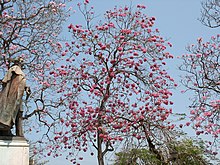| Tabebuia rosea | |
|---|---|

| |
| Scientific classification | |
| Kingdom: | Plantae |
| Clade: | Tracheophytes |
| Clade: | Angiosperms |
| Clade: | Eudicots |
| Clade: | Asterids |
| Order: | Lamiales |
| Family: | Bignoniaceae |
| Genus: | Tabebuia |
| Species: | T. rosea
|
| Binomial name | |
| Tabebuia rosea | |
| Synonyms[1] | |
|
List
| |
Tabebuia rosea, also called pink poui, and rosy trumpet tree[2] is a neotropical tree that grows up to 30 m (98 ft) and can reach a diameter at breast height of up to 100 cm (3 ft). The Spanish name roble de sabana, meaning "savannah oak", is widely used in Costa Rica, probably because it often remains in heavily deforested areas and because of the resemblance of its wood to that of oak trees.[3] It is the national tree of El Salvador, where it is called "Maquilíshuat".
- ^ "The Plant List: A Working List of All Plant Species". Retrieved June 3, 2014.
- ^ "Tabebuia rosea". Germplasm Resources Information Network. Agricultural Research Service, United States Department of Agriculture. Retrieved 15 September 2015.
- ^ Hernan Rodriguez Navas. 2007. La Utilidad de las Plantas Medicinales en Costa Rica. EUNA, Heredia, Costa Rica. 213pp.